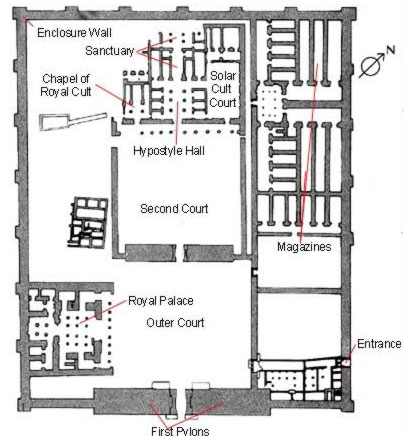The Seti I Temple of Millions of Years on the West Bank at Luxor
by Norman Hayes

The northernmost Temple of Millions of Years on the West Bank at Luxor (ancient Thebes) is that of Seti I. Nineteenth Century travelers called it the Temple of Qurna, while locals call it Qasr el-Rubaiq. In ancient times, the Egyptians named it "Glorious Seti in the West of Thebes". At one time in ancient Egypt, it is likely that administrative center of Western Thebes was situated here, in the village known as Helf-her-nebes, which means, "City in Front of its Master). The temple was originally named, "Seti I is Beneficent in the Domain of Amen, which is on the West of Thebes". Seti I dedicated the temple to his father and the god, Amun-Re. It was meant to compliment his greatest monument, the Hypostyle Hall within the Karnak temple complex across the river.
Because of its location on the West Bank, it was the first stop in the procession known as the Beautiful Feast of the Valley, a privilege it continued to hold up until the Roman period. It was reached by a canal that extended from the Nile along the main overland road on the West Bank that lead to Deir el-Bahari. During the Roman period, it was transformed into a work area for artisans. After Christianity came to Egypt, the northern courtyard became a church, and there were private housing build within the temple itself.

It was also during this period that materials from the temple were used for other building projects. The German Archaeological Institute has studied the ruins, and undertook a restoration program in 1972, repairing and restoring some of this missing material.
Originally, the temple was surrounded by a mud brick enclosure wall with tower buttresses set at intervals. This temple, which faces East towards Karnak, has a triple structure. The outer and middle sections consist of two open courtyards. At the front of the outer enclosure were the massive pylons, now almost gone. Just inside, and against the inner part of the pylons are a pair of colossal sphinxes, though only their pedestals and some other fragments remain. However, the pedestals are inscribed with the name of Seti, and there are a number of "name rings". These "name rings" are inscribed with the names of foreign cities, countries and people who ere considered enemies of Egypt. They have been an invaluable source of geographical information to historians.
There is a hypostyle hall within the temple's center, which is decorated with elegant columns with papyrus fascicles. The south end of this area is dedicated to the cult of the king, while the northern area is dedicated to the solar cult. The sector in the north includes a courtyard with an alter in the center Around the alter are niches with statues of the king. Typical of the Eighteenth Dynasty, the bas reliefs in the temple are extremely elegant.

There was also a ritual palace built in the southern part of the first courtyard, a feature that would be repeated in later temples. This royal palace allowed the deceased king to materialize and participate in the great festivities in the throne room, where he was represented by a statue.
Ramesses I had a very brief reign which was much to short to have built his own temple. Therefore, Seti I began to construct a chapel dedicated to himself in the southern part of this temple. He never completed the chapel, but Ramesses II did, and he also constructed the a great wall and the two pylons of unburned brick. These created a border between the two courtyards. At the time, an avenue of sphinxes passed between the portal of the first pylon and the hypostyle hall.

Regrettably, the pylons of the temple were built with unstable material such as unburned brick. They have now all but disappeared. However, the temple itself, which only represents the rear third of the original structure, was made of sandstone and is in good condition. While the temple is not as grand as works of the latter pharaohs, it did serve as a prototype for all the Ramesside memorial temples built over the next two hundred years.
In the back of the temple itself lies the sacred lake, with a sloping access ramp. Also, on the north side of the temple are storage buildings, their mud brick in much ruin, that once housed grain and other items in support of the priests and workers connected to the temple.
References:
|
Title |
Author |
Date |
Publisher |
Reference Number |
|
Atlas of Ancient Egypt |
Baines, John; Malek, Jaromir |
1980 |
Les Livres De France |
None Stated |
|
Guide to the Valley of the Kings |
Siliotti, Alberto |
1997 |
Barnes & Noble Books |
ISBN 0-7607-0483-x |
|
Valley of the Kings |
Weeks, Kent R. |
2001 |
Friedman/Fairfax |
ISBN 1-5866-3295-7 |
|
Valley of the Kings |
Heyden, A. Van Der |
Al Ahram/Elsevier |


